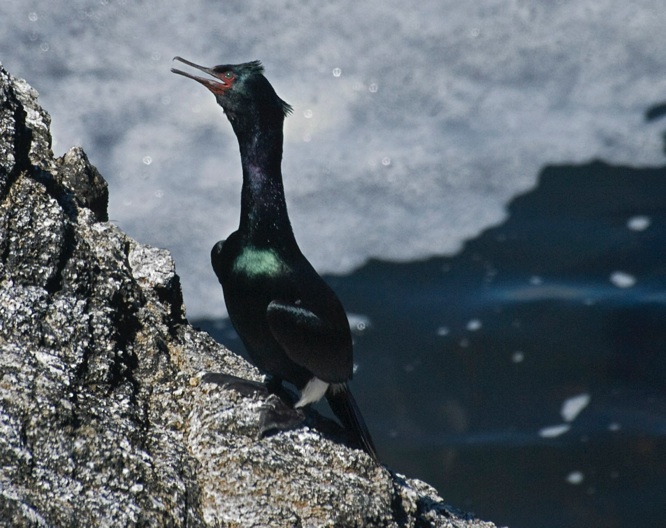A practical guide to bird watching in Sonoma County, California
(Unless otherwise indicated, all phone numbers are in the 707 area code)
A practical guide to bird watching in Sonoma County, California
(Unless otherwise indicated, all phone numbers are in the 707 area code)


Three species of cormorant are normally present in Sonoma County--Double-crested Cormorant (Phalacrocorax auritus), Brandt's Cormorant (Phalacrocorax penicillatus), and Pelagic Cormorant. Brandt's and Pelagic Cormorant are exclusively coastal species. Brandt’s Cormorants may be encountered well out at sea but, despite the name, Pelagic Cormorants usually stay right on the coast. Double-crested Cormorant is common at the coast but just as likely to be found somewhat inland or perched in a tree. Locally, the three species can be found together fairly reliably at the mouth of the Russian River. Pelagic Cormorant is present in Sonoma County all year. Easily seen off Bodega Head on rocks or flying offshore there and in other coastal areas. Nests on offshore rocks, often near Brandt’s Cormorants, but the Brandt’s Cormorants nest in loose groups, favoring flattish or gently sloping rocks, while Pelagic Cormorants pair off and favor much steeper, craggier areas.
A slender, dark cormorant with a thin bill not obviously hooked at the tip. Shows greenish to purplish iridescence in some lights. Overall, blackish grey in non-breeding plumage. During the breeding season, acquires red at the gape--although that can be hard to see in the field, except at close range (photo below). Also acquires white patches at the lower flanks during breeding season, and these are conspicuous, making Pelagic Cormorants very easy to identify, even at long distances, especially in flight. Also shows slight crests on forehead and nape in the summer months.
Often confused with its close relative Brandt’s Cormorant, which, however, is a bigger bird with a much heavier, more clearly hooked bill. Double-crested Cormorant, our other common species (and the most common of the three) is usually less confusing for a number of reasons. As noted above, it may stray inland and perch in trees (virtually eliminating Pelagic and Brandt’s), and it flies with a characteristic kink in the neck lacking in both Brandt's and Pelagic Cormorants, which fly with their necks held relatively straight. Double-crested Cormorant has a conspicuous orange-yellow patch at the throat in all plumages (although much brighter during breeding season). The yellow extends to the lores and may extend along the lower mandible. Pelagic Cormorant, as noted above, has red at the gape when breeding. Brandt's Cormorant has a pale beige to white throat patch that acquires a blue segment in breeding plumage (photo below). Pelagic Cormorant, is the smallest and most slender of the three species and has a notably thin bill without the bulge and conspicuous hook at the tip shared by Double-crested Cormorant and Brandt's Cormorant. The entire head of Pelagic Cormorant looks small when seen beside Brandt's. The 2010 Peterson edition has a good comparison of the heads of the three species on page 81.
Swimming cormorants are often confused with loons at a distance because they swim similarly low in the water and typically with their heads held up, which may suggest Red-throated Loon (Gavia stellata) in particular.
Further reading:
Bolander and Parmeter, Birds of Sonoma County California, rev. ed., 2000, p. 22
Brinkley, National Wildlife Federation Field Guide to Birds of North America, 2007, pp. 85, 94
Burridge, ed., Sonoma County Breeding Bird Atlas, 1995, p. 28
Dunn and Alderfer, eds., National Geographic Field Guide to the Birds of North America, 5th ed., 2006, p. 106
Dunn and Alderfer, eds., National Geographic Field Guide to the Birds of North America, 6th ed., 2011, p. 108
Dunne, Pete Dunne’s Essential Field Guide Companion, 2006, pp. 124-125
Ehrlich, Dobkin, and Wheye, The Birder's Handbook, paperback edition, 1988, p. 28-29
Fix and Bezener, Birds of Northern California, 2000, p. 59
Floyd, Smithsonian Field Guide to the Birds of North America, 2008, p. 101
Kaufman, Field Guide to Birds of North America, 2000, p. 70
Lukas, Bay Area Birds: From Sonoma County to Monterey Bay, 2012, pp. 52-54
Parmeter and Wight, Birds of Sonoma County California, Update (2000-2010), 2012, p. 18
Peterson, Field Guide to Birds of Western North America, 4th ed., 2010, p. 80
Peterson, Western Birds, 3rd ed., 1990, p. 28
Sibley, Field Guide to Birds of Western North America,1st ed., 2003, p. 52
Stokes, Stokes Field Guide to the Birds of North America, 1st ed., 2010, p. 118
Vuilleumier, American Museum of Natural History, Birds of North America: Western Region, 2011, p. 101
Voice: Cornell Lab of Ornithology: All About Birds--Pelagic Cormorant
© Colin Talcroft, 2009, 2010, 2011, 2012, 2013, 2014, 2015, 2016
Unless noted, all photos by the author. If you would like to use one of my images, please ask for permission for non-commercial use with proper credit or commercial use with proper compensation.

For comparison: Double-crested Cormorant drying its wings.
Spring Lake, Santa Rosa, September 23, 2012

Pelagic Cormorant
Phalacrocorax pelagicus
Pelagic Cormorant (non-breeding plumage), Porto Bodega, Bodega Bay, March 10, 2010
1990-2015 Sonoma County data. Graph provided by eBird (www.ebird.org), generated October 29, 2015
EBird reported occurrence in Sonoma County

For comprison: Brandt’s Cormorant
Santa Cruz County, May 26, 2014


Pelagic Cormorant (breeding plumage), Bodega Head, Bodega Bay, June 20, 2011

